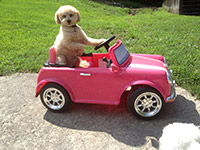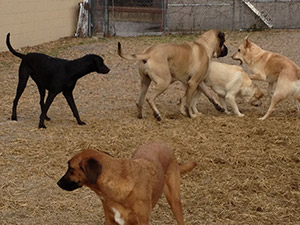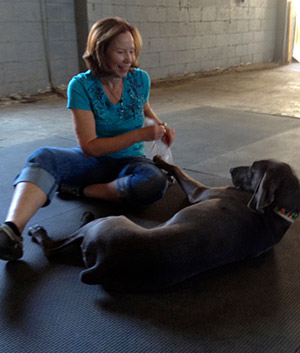
Red Rover Pet Services LLC, Training, Dog Boarding, Poodle Rescue, & More
Nashville's original social dog place to play & stay!
DOG BRAWL!! Is It Normal? What Can We Do?

Do you get irritated with other people? You’d have amazing self control or be highly evolved spiritually if you didn’t. So why are we surprised when dogs get irritated with each other too?
Rather than engaging in road rage or yelling, dogs often use physical means to resolve disputes.
 Though the image of an angry dog behind the wheel is worth contemplating…
Though the image of an angry dog behind the wheel is worth contemplating…
DOG LANGUAGE
Dogs exchange a lot of “language”—non-verbal—with each other immediately and it continues at a rapid pace. Some scientists trained in
animal behavior believe that dogs communicate constantly and that every movement, no matter how SMALL, has BIGmeaning. Regardless of what you believe it is clear dogs communicate with others.
When a fight breaks out the dog who seems to start it, from a novice human perspective, is often responding to something the other dog “said” long before. Dogs use their bodies—eyes, mouth, tails, hair along the back and neck, ears, etc.—in addition to posture, speed and direction of approach, vocalizations, and who knows what else to communicate with each other.
HOW CAN YOU HELP YOUR DOG?
It’s important for our puppies to have good interactions with other dogs regularly during the first four months of life, an important learning period for canines. Unfortunately many dogs grow up alone in our society and that can cause problems.Learning from and engaging with other social dogs—who have play and conflict resolution styles that are healthy and reasonable—is very important for social behavior.
A well run, cage-free dog daycare like Red Rover offers an important service in this day and age of single dog homes; an opportunity for those “only” dogs to learn from other dogs as safely as possible. Not to mention the opportunity to play and enjoy being around their own kind!
Puppies who grow up regularly attending our daycare experience play styles typical of small dogs while they’re little, learn from social and mature dogs who can be great at teaching them how to get along with others, and continue learning from their own species throughout life. It is interesting to note, in my experience, small dogs rarely cause injuries—even minor ones—to other dogs in their group!
Teaching your dog to respond quickly to her name and come when called is another great way to keep your dog, and you, safe. If our dogs are responsive to our calls and we know what to watch for, we can safely end a canine-to-canine interaction that isn’t going well before a fight breaks out.
 By putting our hands on dogs in conflict or otherwise getting in their way; we greatly increase tension in those dogs and increase the chance of a physical fight between them.
By putting our hands on dogs in conflict or otherwise getting in their way; we greatly increase tension in those dogs and increase the chance of a physical fight between them.
Teaching bite inhibition is also important for avoiding injuries. While we can and should teach our pups not to bite hard by giving them input when they mouth us in play, dogs learn more quickly from other dogs. They learn how much bite pressure ends play and what behaviors result in a correction from an adult. These social dogs may be less likely to cause injuries to others throughout their lives.
Dogs raised playing with others have learned to use their mouths at a pressure that is non-injuring for another dog but can be too hard for human skin. While most physical altercations I see between social dogs result in no injury to either dog, a human in between is much more likely to get a puncture or injury to their skin.
 Taking classes that help build a happy bond with your dog that emphasizes trust can lead to a better understanding of your dog that will increase safety while playing with other dogs. I dedicate time in our beginning and intermediate group classes to watch play between dogs and explain to the humans what body language to watch for in their dogs, making it specific for each dog.
Taking classes that help build a happy bond with your dog that emphasizes trust can lead to a better understanding of your dog that will increase safety while playing with other dogs. I dedicate time in our beginning and intermediate group classes to watch play between dogs and explain to the humans what body language to watch for in their dogs, making it specific for each dog.
We have great books available to borrow from our free library for our local customers, a few are mentioned below. If you’re not local, I encourage purchasing or borrowing them from another source. Amazon and DogWise.com are great resources for purchase.
RESOURCES FOR MORE READING
Calming Signals: On Talking Terms With Dogs, by Turid Rugaas
It’s a quick read and very enlightening.
Dog Language – An Encyclopedia of Dog Language, by Roger Abrantes
A guide to canine body postures arranged from A to Z written by a respected and well-known scientist who specializes in animal behavior.
Canine Body Language: Interpreting the Native Language of the Domestic Dog by Brenda Aloff
A photographic guide to the language of dogs.
©Red Rover Pet Services 2023